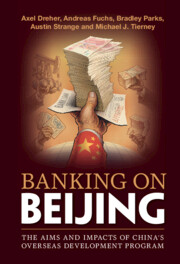Book contents
- Banking on Beijing
- Banking on Beijing
- Copyright page
- Contents
- Figures
- Tables
- Acknowledgments
- Abbreviations
- 1 Why Do We Know So Little about the Aims and Impacts of China’s Overseas Development Program?
- 2 The Journey to Global Creditor
- 3 Counting and Comparing Apples and Dragon Fruits
- 4 Follow the Money
- 5 Apples and Dragon Fruits
- 6 Aid à la Carte
- 7 Paving the Way to Growth and Development?
- 8 Poisonous Dragon Fruits?
- 9 Banking on the Belt and Road
- Postscript: Analysis of China’s Overseas Development Program During the BRI Era With an Updated Dataset
- References
- Index
9 - Banking on the Belt and Road
The Future of Global Development Finance
Published online by Cambridge University Press: 21 April 2022
- Banking on Beijing
- Banking on Beijing
- Copyright page
- Contents
- Figures
- Tables
- Acknowledgments
- Abbreviations
- 1 Why Do We Know So Little about the Aims and Impacts of China’s Overseas Development Program?
- 2 The Journey to Global Creditor
- 3 Counting and Comparing Apples and Dragon Fruits
- 4 Follow the Money
- 5 Apples and Dragon Fruits
- 6 Aid à la Carte
- 7 Paving the Way to Growth and Development?
- 8 Poisonous Dragon Fruits?
- 9 Banking on the Belt and Road
- Postscript: Analysis of China’s Overseas Development Program During the BRI Era With an Updated Dataset
- References
- Index
Summary
This chapter reviews the first six years of implementation of the Belt and Road Initiative (BRI), a major Chinese foreign policy initiative introduced in 2013. The authors explain how China’s transition from benefactor to banker, in con- junction with its push for expanded influence on the global stage, led to the adoption of the BRI. They then consider whether and why China might choose to ‘multilateralize’ the BRI. The authors conclude that if Beijing wants to multilateralize the BRI, it will need to either comply with—or help redesign— international development finance rules and standards. At the same time, the establishment of an inclusive and revitalized development finance regime does not rest solely on the shoulders of Beijing. If OECD-DAC and multilateral donors and creditors wish to avert a crisis of confidence and relevance, they will need to rewrite international development finance rules and norms in ways that accommodate Beijing’s interests and more effectively account for the preferences of low-income and middle-income countries.
Keywords
- Type
- Chapter
- Information
- Banking on BeijingThe Aims and Impacts of China's Overseas Development Program, pp. 282 - 302Publisher: Cambridge University PressPrint publication year: 2022

